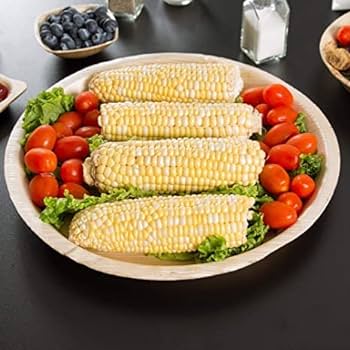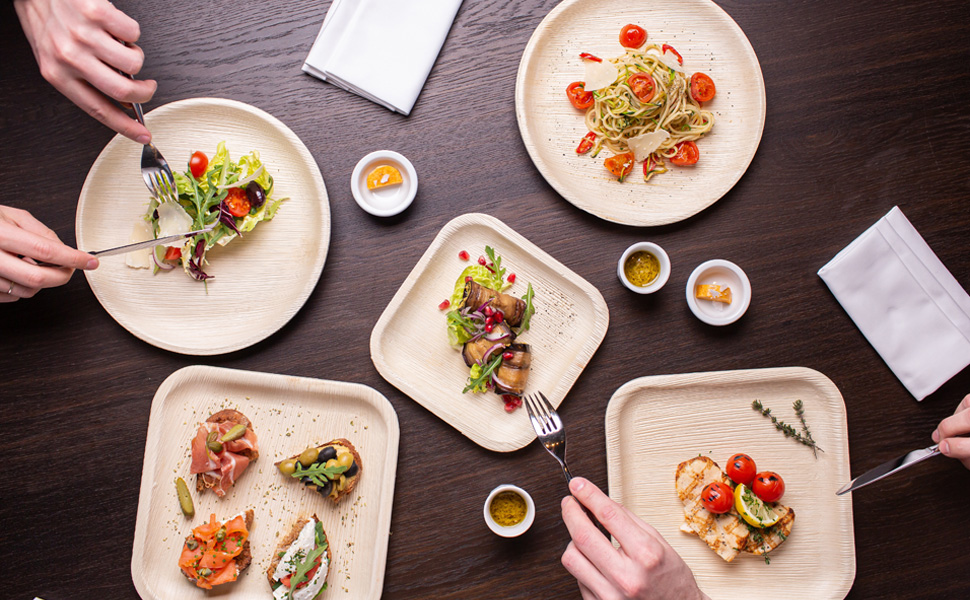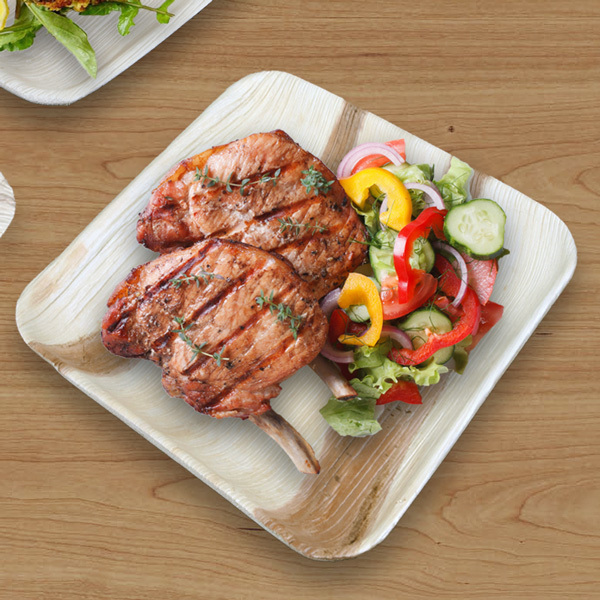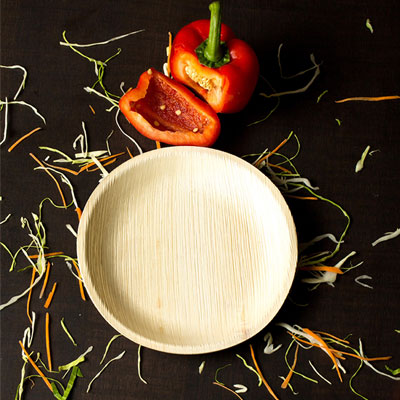“Discover the eco-friendly elegance of Palm Leaf Tableware with our ultimate guide. Learn about sustainable dining solutions for every occasion. Shop now!”
Introduction
In today’s world, where environmental conservation is more crucial than ever, making eco-friendly choices in every aspect of our lives is paramount. One such sustainable choice is opting for palm leaf tableware over traditional dining options. This guide aims to explore the myriad benefits, manufacturing processes, and versatility of palm leaf tableware, providing a comprehensive look into why these eco-friendly alternatives are not just better for the planet but also for our daily lives.
Table of Contents
Why Choose Palm Leaf Tableware?
Environmental Sustainability
Palm leaf tableware is crafted from the naturally fallen leaves of the Areca palm tree, meaning no trees are cut down to produce them. This process significantly reduces the environmental impact compared to traditional plastic or paper tableware, which often involve deforestation, pollution, and contribute to the growing problem of landfill waste. Palm leaf products are biodegradable and compostable, breaking down naturally without leaving harmful residues, thereby contributing to a healthier planet.
Durability and Usability
Despite being entirely natural, palm leaf plates and bowls are incredibly durable. They are sturdy enough to handle heavy and wet foods without bending or leaking, making them suitable for a wide range of dishes, from hot meals to cold desserts. Moreover, they are microwave-safe and can handle hot foods without any issues, offering a convenience that matches their eco-friendly benefits.
Aesthetic Appeal
Palm leaf tableware comes with a unique, rustic look that adds an elegant touch to any dining occasion. Each piece has its own texture and pattern, reflecting the natural beauty of the leaf it was made from. This can elevate the presentation of meals, making the tableware a popular choice for weddings, parties, and other events where visual appeal is important.
Health and Safety
Unlike some plastic products, palm leaf tableware is free from chemicals and synthetic materials. It does not leach harmful substances into food, making it a safer choice for everyone, especially when serving hot food. This aspect is particularly appealing for parents, health-conscious individuals, and anyone looking to minimize their exposure to toxins.
Versatility
Palm leaf tableware is suitable for a variety of settings, from casual gatherings to formal events. Its natural elegance complements any décor style, and its environmental credentials make it a conversation starter. Whether it’s a backyard barbecue, an elegant wedding, or daily meals at home, palm leaf tableware fits seamlessly into any occasion.
Economic Benefits
By choosing palm leaf tableware, consumers and businesses can also support sustainable economic practices. The production of palm leaf tableware often provides employment opportunities in rural areas, where economic options may be limited. This supports local communities and encourages sustainable practices that are economically viable

How Is Palm Leaf Tableware Made?
1. Collection of Fallen Leaves
The process begins with the collection of fallen leaves from the Areca palm tree, which naturally shed their leaves several times a year. This sustainable sourcing method ensures that no trees are cut down or harmed, maintaining ecological balance and promoting a cycle of natural renewal.
2. Cleaning
Once collected, the leaves are thoroughly cleaned with water to remove any dirt and debris. This step is crucial to ensure that the final product is hygienic and safe for food contact. The cleaning process is generally done without the use of harmful chemicals, keeping the product natural and eco-friendly.
3. Sorting and Trimming
After cleaning, the leaves are sorted based on size and quality. Only the best leaves are selected for the production of tableware. Some leaves might be trimmed to remove any damaged or uneven edges, preparing them for the next stage of the process.

4. Heat Pressing
The cleaned and trimmed leaves are then subjected to a heat-pressing process. They are placed in a mold that shapes them into plates, bowls, or other types of tableware. The heat and pressure from the mold sterilize the leaves and bind them together, creating a sturdy and durable product. This process is completely natural and does not involve any adhesives or chemicals.
5. Shaping and Finishing
After pressing, the tableware is sometimes further shaped or trimmed to ensure a uniform appearance. Edges might be smoothed, and any final adjustments are made to meet quality standards. This step ensures that each piece of tableware is not only functional but also aesthetically pleasing.
6. Packaging
Once the tableware has passed quality control, it is packaged for sale. The packaging is often made from eco-friendly materials as well, maintaining the sustainable ethos of the product from start to finish.
7. Composting
After its useful life, palm leaf tableware can be composted. It breaks down naturally, turning into nutrient-rich compost that can benefit the soil, completing its lifecycle in an eco-friendly way.
Benefits of the Manufacturing Process
The process of making palm leaf tableware has several environmental benefits. It promotes a zero-waste philosophy, as the raw materials are naturally sourced and the final product is biodegradable. Moreover, the manufacturing process is energy-efficient, often relying on simple machinery and minimal processing. This not only reduces carbon footprint but also supports sustainable livelihoods in rural areas where the leaves are collected and processed.
Caring for Your Palm Leaf Tableware
Single-Use vs. Limited Reuse
Primarily, palm leaf tableware is designed for single use, offering a convenient and eco-friendly alternative to traditional disposable plates and cutlery. However, with gentle handling and proper care, it can sometimes be reused for serving dry or less messy foods. It’s important to note, though, that they are not suitable for washing in a dishwasher or soaking in water, as this can compromise their structure and appearance.
Cleaning for Reuse
If you decide to reuse palm leaf tableware for another meal, wipe the surface with a damp cloth to remove any residue. For slightly soiled tableware, a quick rinse under tap water might suffice, but ensure it’s dried immediately and thoroughly to prevent warping or softening. Avoid using any harsh detergents or scrubbers that can damage the natural surface of the tableware.
Storage
Store your palm leaf tableware in a cool, dry place to maintain its durability and prevent any moisture-induced damage. If you have unused palm leaf plates or bowls, keep them in their original packaging or a well-ventilated container to protect them from dust and humidity until they’re ready to be used.
Disposal
One of the most significant advantages of palm leaf tableware is its compostability. After its use, if you choose not to reuse it, you can compost the tableware to contribute to a nutrient-rich compost pile. This not only helps reduce waste but also returns valuable nutrients to the soil. Ensure that your local composting facility accepts biodegradable tableware, or consider starting a compost bin if you have the space for it.
Event Planning
When planning an event where palm leaf tableware will be used, consider how you can communicate its eco-friendly features to your guests. Some might even be interested in taking their used plates home for composting, further extending the environmental benefits of choosing palm leaf over plastic or paper alternatives.
Crafting and Upcycling
Before disposing of or composting your palm leaf tableware, consider any potential upcycling projects. Its sturdy nature and attractive appearance make it suitable for various crafts and decorations, from creating wall art to serving as a base for eco-friendly projects.
Educational Opportunities
Use the lifecycle and care of palm leaf tableware as an educational tool to teach others about sustainability and eco-friendly living. Sharing how to care for and properly dispose of these items can inspire more sustainable choices in your community.

Comparing Palm Leaf to Other Eco-friendly Alternatives
Palm Leaf vs. Bamboo
Sustainability: Both palm leaf and bamboo are highly sustainable resources. Palm leaf tableware is made from fallen leaves, requiring no tree cutting or intensive farming. Bamboo, while also a rapidly renewable resource, requires harvesting and can be grown in a variety of environments without pesticides or fertilizers. However, bamboo processing can be more resource-intensive than palm leaf production, which is relatively simple and requires less energy.
Durability: Both materials are known for their durability. Palm leaf plates can handle heavy and wet foods without bending or leaking, similar to bamboo. Bamboo might have a slight edge in terms of being used for a broader range of products, including cutlery and reusable items, due to its inherent strength.
Aesthetic Appeal: Palm leaf tableware offers a unique, rustic look that can vary with each piece, adding a natural and elegant touch to table settings. Bamboo has a more uniform appearance and can be crafted into a sleek, modern look, appealing to different aesthetic preferences.
Environmental Impact: Both options are compostable and biodegradable, but palm leaf typically breaks down faster than bamboo due to its thinner and less dense structure. The simpler manufacturing process of palm leaf tableware also means its carbon footprint can be lower than that of bamboo products.
Palm Leaf vs. Paper
Sustainability: Paper products, while often made from renewable resources, can contribute to deforestation unless made from recycled materials or sourced from sustainably managed forests. Palm leaf tableware, on the other hand, utilizes naturally fallen leaves, posing no harm to living trees and requiring minimal processing.
Durability: Palm leaf tableware generally offers superior durability compared to paper. It is better at handling wet or greasy foods without soaking through or falling apart, making it a more versatile option for various culinary needs.
Aesthetic Appeal: Paper products can vary widely in appearance, from plain and functional to decorative and themed. Palm leaf provides a consistently natural and upscale look, suitable for both casual and formal events.
Environmental Impact: Both palm leaf and paper are biodegradable and compostable, but palm leaf has a smaller environmental footprint due to its minimal processing and natural compostability. Paper recycling can mitigate some environmental impacts, but the recycling process itself requires water and energy.
Palm Leaf vs. Bioplastics
Sustainability: Bioplastics are made from renewable biological sources, such as corn starch, and are often touted as a sustainable alternative to petroleum-based plastics. However, the production of bioplastics can still involve intensive agricultural practices and competition with food production. Palm leaf uses agricultural waste products, offering a more efficient use of resources.
Durability: Bioplastics vary in durability and may not always perform as well as palm leaf in terms of heat resistance and stiffness. Palm leaf tableware’s natural rigidity and ability to handle a variety of foods make it a strong competitor.
Aesthetic Appeal: Bioplastics often mimic the look of traditional plastics, which might not add the same natural or elegant touch as palm leaf tableware to a dining setting.
Environmental Impact: While bioplastics are designed to be more environmentally friendly than conventional plastics, their biodegradability and compostability can vary widely and sometimes require industrial composting facilities. Palm leaf tableware, in contrast, can decompose more readily in a home composting system, making it a more eco-friendly option in terms of end-of-life disposal.

Where to Buy Palm Leaf Tableware
Online Retailers
One of the most convenient ways to purchase palm leaf tableware is through online platforms. Websites like Amazon, Etsy, and eBay offer a wide range of palm leaf products from various sellers. You can find an extensive selection of shapes, sizes, and package quantities, suitable for different occasions and needs.
Eco-Friendly Specialty Stores
Many stores that focus on eco-friendly and sustainable products carry palm leaf tableware. These specialty retailers often provide a curated selection of high-quality, environmentally responsible items, including palm leaf plates, bowls, and serving trays.
Wholesale Suppliers
For event planners, caterers, or businesses looking to purchase in bulk, wholesale suppliers are an excellent option. Companies like GreenPaperProducts, Eco-Products, and Bio & Chic specialize in eco-friendly tableware and often offer competitive pricing for large orders.
Local Health Food Stores and Markets
Some local health food stores, organic markets, and co-ops stock palm leaf tableware as part of their commitment to sustainable living. Shopping locally for palm leaf products can also support small businesses and reduce the carbon footprint associated with shipping.
Trade Shows and Eco-Focused Expos
Trade shows and expos focusing on sustainability and eco-friendly products are great places to discover palm leaf tableware. These events often feature the latest in sustainable innovations, allowing you to explore and compare different brands and products in person.
Directly from Manufacturers
Purchasing directly from manufacturers can be another way to buy palm leaf tableware. This option might be especially useful for businesses looking to customize their orders or seeking to establish long-term supply relationships
Tips for Buying Palm Leaf Tableware
- Research: Look for reviews and ratings to ensure you’re buying high-quality palm leaf tableware.
- Compare: Prices and quantities can vary significantly, so compare options to find the best deal.
- Eco-Certifications: Check for any eco-certifications or sustainability credentials to ensure the products meet environmental standards.
- Shipping: Consider the shipping costs and policies, especially if you’re ordering in bulk or from a distance.

Conclusion
Embracing palm leaf tableware is a step forward in our journey towards sustainable living. Its environmental benefits, versatility, and aesthetic appeal make it an excellent choice for anyone looking to reduce their carbon footprint without sacrificing convenience or style.
FAQs
- Is palm leaf tableware compostable? Yes, it’s 100% compostable, breaking down naturally without harming the environment.
- Can palm leaf plates handle hot foods? Absolutely, they are heat resistant and suitable for hot dishes.
- Are palm leaf products sustainable? Yes, they are made from naturally fallen leaves and contribute to reducing waste and pollution.
- Can I reuse palm leaf tableware? While designed for single-use, they can be reused for dry foods or as decorative items.
- Where can I purchase palm leaf tableware? They are available at many online retailers, eco-friendly shops, and specialty stores.
